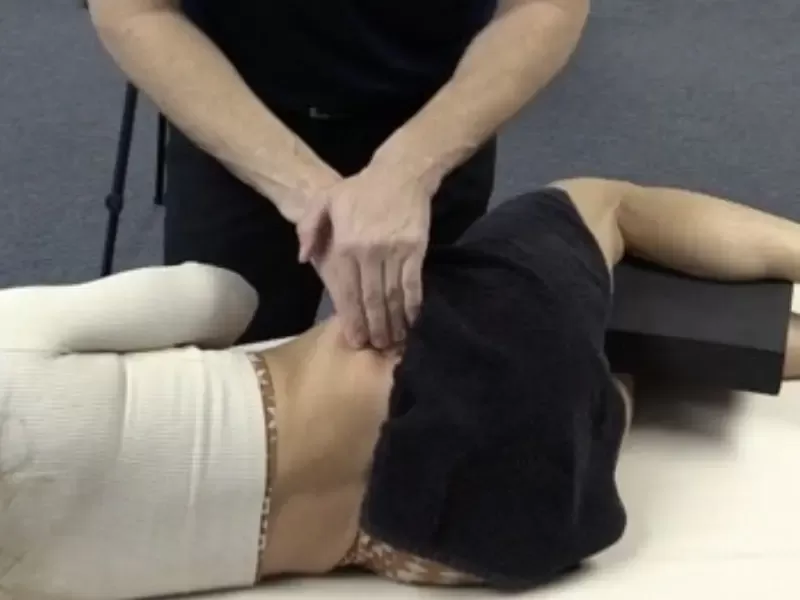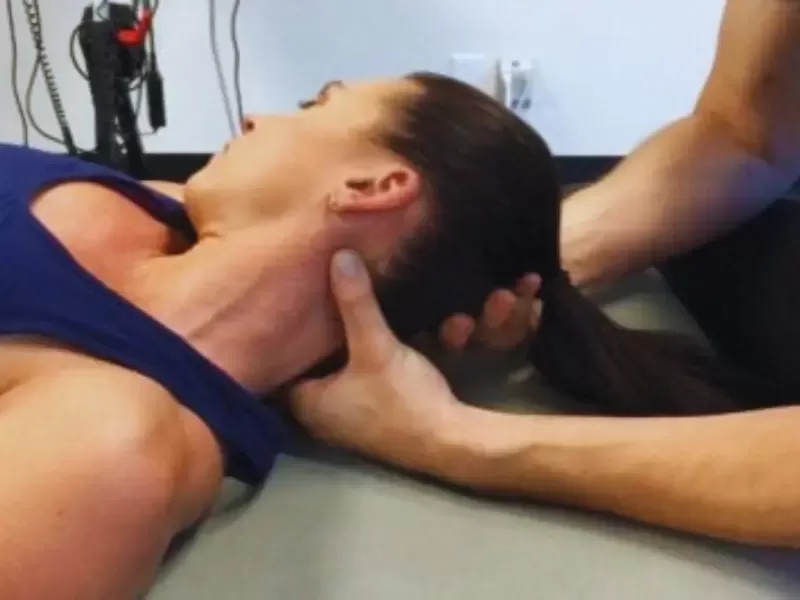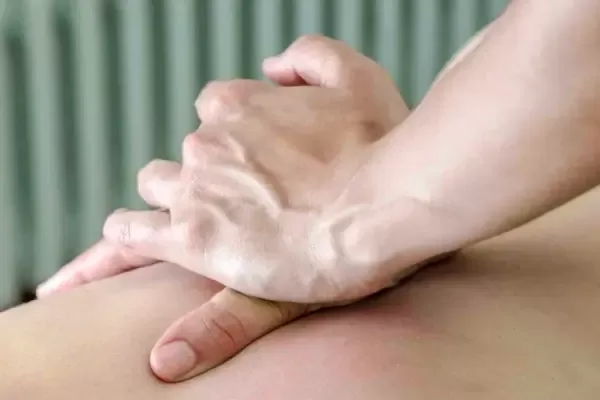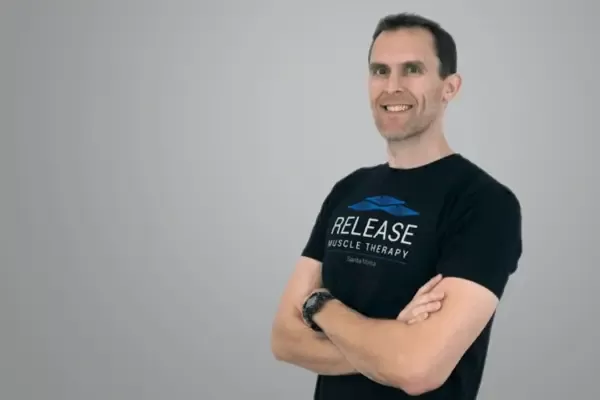Resolve Chronic Muscle Tension with Our Myofascial Release Massage
-
Complete Evaluation
-
No Spinal Manipulation
-
Painless Massage Techniques
-
Home Exercise Program
Get Started with a FREE 1:1 Phone Consult
We Provide Expert Myofascial Release Therapy in Fallbrook
Our Myofascial Release Therapy focuses on identifying and addressing the underlying restrictions in your connective tissues, providing targeted relief and lasting results.
Myofascial release massage is a commonly used hands-on massage modality aimed at connective tissues restrictions that limit movement and may contribute to pain.
This style of therapy often uses light contact to induce a stretch in tissues, and it’s held until a “release” in the tissue is felt. This can be anywhere from 20 seconds up to 2 minutes or more.
Can you really release fascia?
In my article HERE, I discuss the controversial topic of myofascial release therapy, but that does not mean that the techniques themselves aren’t useful. In my practice, I will use any technique to accomplish the ultimate outcome of relaxing the tissues, the nervous system, and achieving pain relief.

Myofascial Release Therapy Provides More Than Just Massage

We begin by thoroughly evaluating the factors contributing to your discomfort, aiming to uncover the most critical elements of your pain experience. This process includes assessing your movements to identify patterns that may trigger discomfort, pinpointing specific areas of tension or pain, and understanding how your soft tissues respond to pressure or stress.

Using the insights gathered during the discovery phase, we craft a personalized action plan that directly addresses your body’s specific challenges. This plan strategically targets muscle imbalances, movement dysfunctions, and underlying sources of pain to prepare your body for effective healing. It includes precise interventions, clear goals and practical steps to guide your progress.

Your personalized therapy program is designed for precision and includes:
- Hands-on Techniques like myofascial release and neuromuscular therapy.
- Targeted Exercises to improve strength and mobility.
- Lifestyle Adjustments to ensure lasting results.
At Release Muscle Therapy we use a combination of Therapeutic Movement and Myofascial Release Massage to:
 Reduce Pain
Reduce Pain
Myofascial release targets restrictions in the fascia, helping to alleviate chronic pain by addressing the underlying causes of discomfort.
 Ease Muscle Tension
Ease Muscle Tension
Through gentle, sustained pressure, this therapy softens tight connective tissues, reducing tension and promoting relaxation.
 Restore Balance
Restore Balance
By releasing restrictions in the fascia, myofascial release helps realign soft tissues, restoring balance and improving overall body function.
 Increase Range of Motion
Increase Range of Motion
This therapy relieves restrictions in your connective tissues, allowing for smoother, pain-free movement and greater mobility.
 Improve Flexibility
Improve Flexibility
Stretching and softening the fascia reduces stiffness, making it easier for your body to move freely and with less effort.
 Reduce Scar Tissue
Reduce Scar Tissue
After surgery or injury, myofascial release helps minimize adhesions and scar tissue, speeding up healing and improving tissue mobility.
 Calm the Nervous System
Calm the Nervous System
These techniques soothe overly sensitive nerves, decreasing the effects of physical and emotional stress on the body.
 Enhance Circulation
Enhance Circulation
Improved blood flow from therapy promotes faster healing and keeps tissues healthy, supporting recovery and reducing soreness.
 Hydrate Connective Tissue
Hydrate Connective Tissue
By encouraging better hydration of the fascia, myofascial release helps maintain healthy, pliable tissues that are less prone to stiffness or pain.
Myofascial Release Massage And Trigger Points
Trigger points are commonly associated with myofascial release techniques.
A trigger point is described as a hyper-irritable spot, “knot”, or nodule in the muscle tissues. Direct compression or stimulation of this spot can produce either localized or referred discomfort.
Much like the topic of fascial release, the concept of trigger points has come under fairly heavy scrutiny, especially as a primary cause of pain.
While its not possible to completely eliminate trigger points, they can be de-sensitized, and this is often associated with improvements in pain levels.

Who Benefits From Myofascial Release Massage Therapy?
Generally speaking, since myofascial release is a massage technique, it can be beneficial for all of the same issues/conditions you might seek out massage, including:
-
Neck pain
-
Back pain
-
Tendinitis
-
Postural imbalance
-
Knee pain
-
TMJ (jaw dysfunction)
-
Shoulder pain
Specifically, myofascial release is helpful in situations where pressure into the tissues isn’t tolerated well (due to increased sensitivity). The very low intensity stretch with longer hold times can be effective for these sensitive tissues and offer great results.

What Are The Benefits of Myofascial Release?
Myofascial release therapy in Fallbrook has the power to help treat deep muscle tension, somatic dysfunction and pain by working the areas around your muscles, ligaments and tendons. Often referred to as “fascia”, a myofascial release massage therapist works these areas with firm pressure to help increase your range of motion and help promote circulation.
Note that myofascial release therapy is not like traditional massages that focus almost exclusively on your muscles. Instead of kneading motions that are intended to break down “knots” in the muscles, myofascial muscle release therapy deals with the overly sensitive nerves, helping to alleviate pain via steady pressure for minutes at a time. As the fibers stretch and soften, and nerves reduce sensitivity, a greater range of motion can be achieved.
Post-Injury and Post-Surgery Benefits
For patients, myofascial release therapy can help correct muscle imbalances, as well as improving range of motion and flexibility. After surgeries or injuries, myofascial release therapy may also help reduce scar tissue and adhesion, and sometimes it may even be helpful as a supplemental therapy to alleviate headaches or migraines associated with tension.
Relieving Stress and Improving Performance
If you suffer from joint stress or muscle soreness, or even if stress is taking over your life, myofascial release therapy can help. Active individuals may even notice getting more out of their warm-ups and routines, which is in part caused by the increased blood flow and tissue hydration from myofascial release therapy.
Managing Chronic Pain with Myofascial Therapy
Additionally, myofascial muscle release therapy can be a crucial component in managing chronic pain, especially pain that may be influenced by a lack of flexibility and other issues with the body’s connective tissue. Sometimes it may even be recommended for a patient to use a foam roller at home to better support the treatment.
Types of Myofascial Release Therapy
Keep in mind that there are multiple types of myofascial release therapy, and they’re often categorized as passive or active. Passive myofascial release therapy is where the treatment is guided by the therapist and how the patient’s body reacts to the treatment. On the other hand, active myofascial release therapy requires both patient and therapist to work in unison as the patient contracts and releases muscles where work is to be done.
Learn How Myofascial Release Therapy Helps Relieve Your Pain
Myofascial release therapy isn’t just about treating symptoms—it’s about addressing the deeper dysfunctions in your body’s connective tissue system that may be holding you back.
Fascia, the connective tissue surrounding your muscles, can become restricted from stress, injuries, or poor posture, creating pain and limiting movement. Myofascial release focuses on relieving these restrictions to restore your body’s natural balance and efficiency.
This therapy is uniquely effective for individuals who experience heightened sensitivity or pain that doesn’t respond well to traditional massage techniques. By applying gentle, sustained pressure, myofascial release helps calm the nervous system, allowing your body to move with less tension and greater freedom.
At Release Muscle Therapy, we understand that pain is complex. That’s why we integrate myofascial release with customized care plans that address your body’s unique needs. From reducing adhesions and scar tissue after surgery to alleviating chronic conditions like TMJ dysfunction or postural imbalances, this therapy is designed to meet your specific goals.
In addition to its physical benefits, myofascial release therapy promotes relaxation on a deeper level. Many clients find it helps alleviate stress, reduce tension-related headaches, and support overall wellness. For active individuals, it’s also a game-changer—enhancing recovery, improving flexibility, and helping you get more out of your training.
With the right combination of hands-on therapy, follow-up exercises, and personalized guidance, myofascial release therapy can help you move past pain and regain control over your body.
Whether you’re looking to resolve long-standing issues or prevent future ones, this gentle yet powerful approach is here to support your journey to lasting relief.
What Does A Myofascial Release Session Look Like?
Following a comprehensive initial evaluation to identify the potential root cause(s) of your concerns, targeted hands-on techniques are applied to the areas that will benefit most.
Not everyone requires myofascial release techniques. During your initial evaluation, we may discover that movement-based therapy is more effective for your specific needs.
If myofascial release or trigger point therapy is indicated, we’ll select the most appropriate tools for your treatment—such as hands, percussion massagers, or IASTM tools—and apply them directly to the affected areas. In most cases, only the clothing over the targeted area needs to be removed to access the tissues effectively.
Once the therapy is complete and the tissues are appropriately released, follow-up techniques are used to “condition” the tissues and support the normalization of your newly improved range of motion.
This process often involves a combination of stretching and muscle activation techniques to reinforce the progress made during the session.
Our Proven Myofascial Release Therapy Techniques Have Brought Pain Relief to Your Neighbors in Fallbrook
Meet Fallbrook’s Top Rated Massage Therapist – Sam Visnic
I’ve spent the last 20 years studying dozens of muscle release therapy systems and methodologies for uncovering the root cause of aches and pains, along with postural and movement issues in order to answer the question; “what is the best treatment for chronic pain?”.
In a world of specialists, surgical procedures, drugs and quick fix remedies, I’m committed to finding and developing strategies that help people stuck in the pain “gap.”

Frequently Asked Questions About Myofascial Release Therapy
Myofascial Release Therapy is a specialized hands-on technique that focuses on releasing restrictions in the fascia—the connective tissue surrounding your muscles and bones. By addressing tension and adhesions in the fascia, this therapy helps reduce pain, improve mobility, and restore balance throughout your body.
This therapy is highly effective for addressing conditions like chronic pain, tightness in the shoulders or neck, lower back pain, TMJ issues, post-surgical adhesions, and mobility restrictions caused by scar tissue or repetitive strain injuries.
Unlike traditional massage, which often focuses on muscle relaxation, Myofascial Release Therapy targets the fascia. This involves applying sustained pressure to specific areas for a longer period of time to release tension and restore flexibility in the connective tissue.
During a session, your therapist will assess areas of restriction and apply gentle, sustained pressure to release tension in the fascia. The techniques are tailored to your specific needs, and sessions are typically slower-paced to allow the tissue to release naturally.
While some areas of tightness may feel tender during treatment, the therapy is generally not painful. Most clients describe the sensation as a deep but tolerable pressure that often brings immediate relief as the fascia releases.
No, we do not accept insurance as a form of payment at this time, nor do we provide insurance coding for billing purposes. Only a receipt of services will be supplied upon request.








